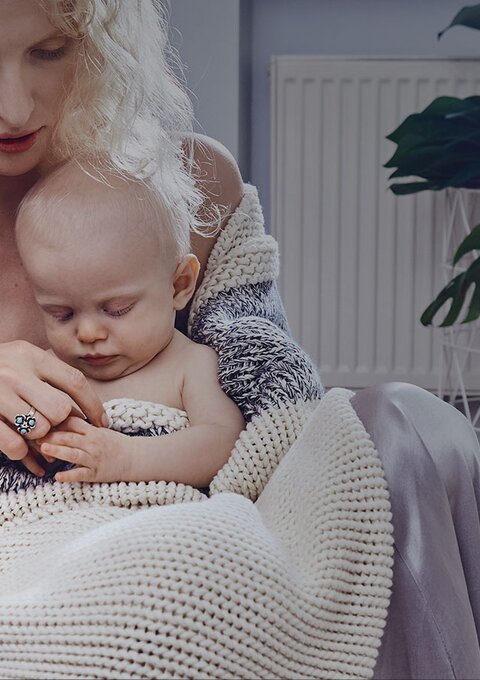Breastfeeding mums may face the situations where it is necessary to express milk: a small amount to relieve full breasts or more to feed the child. You can express milk manually or with a breast pump.
If you temporarily can not breastfeed, express milk at least 8 times a day to maintain appropriate lactation intensity. In the beginning you may have problems to express much milk, but after a few days you will be able to obtain more and more.
Breast fullness (to express small amount of milk before feeding).
Low milk supply (to stimulate lactation).
Inverted or flat nipples (to improve their shape before latching on).
Baby refuses to suckle or suckles inefficiently.
Breasts are heavy, and tight, and you do not want to wake the baby.
Baby is away from his mum.
There was a long break between feedings and the nipple is difficult to grasp.
It is good for expressing small amounts of milk:
Wash your hands with soap, and sit comfortably in a chair. Imagine you are feeding your baby or place his photo in front of you.
Gently massage the breast stroking it from the outside towards the areola. Do not pinch or press the breast.
Place your thumb and index finger on the margin of the areola, forming a C letter, about 3 cm from the nipple.
Press your fingers to your chest and squeeze, bringing them closer to each other. Do not change fingers position when pressing.
Repeat pressing while grasping the breast with fingers at different angles.
Before expressing wash your hands thoroughly and make sure the pump is clean and scalded.
You can take a warm shower or put a compress on the breast to stimulate milk let down.
Sit comfortably with good back support. Place the baby's photo in front of you or express milk in his presence - eye contact with your child stimulates lactation. Do not express milk when you are stressed or tired, as it inhibits milk flow.
Place the nipple deep into the funnel and press the breast massage pad so that it tightly covers the breast, preventing air outflow. The nipple should be located in the center of the pump opening.
Start expressing with stimulation of the breast. If you are using a manual breast pump press its handle with shallow, rapid movements. You do not need to press it fully down. If you have choose an electric two-phase breast pump switch on the first expressing mode (first phase).
While expressing with manual breast pump you will notice the milk flow, express making short movements for a while and then start deep expressing: press the handle to the end and release it after about 2 seconds. You will notice the milk coming steadily from the breast. This slower, deeper expressing imitates breast suckling by an infant.
If you use an electric breast pump and you notice the milk begins to flow change the simulation mode for deeper expressing. If you do not switch the mode the breast pump will do it automatically after about 2 minutes.
If you want to increase the let down speed during expressing, lean forward a bit, but still keeping the bottle upright, and sitting comfortably.
In the beginning express milk from each breast for only a few minutes. Do not expect to immediately fill the bottle. As you get used to expressing the amount of milk will increase.
Using a manual breast pump for expressing larger amount of milk you can follow a "7-5-3" scheme (alternate expressing from each breasts for 7, 5, and 3 minutes) or first express milk for a longer time from one breast and then from the other.
You can store milk in disposable bags or silicone or plastic bottles fitted with a sealing disc.
If you want to freeze milk, do it immediately after feeding. Note down the expressing date on the bag or the bottle.
Thaw milk starting from the earliest frozen portions. You can leave it in a refrigerator for 24 hours or thaw it in a bottle warmer. Do not thaw milk in a microwave. Thawed food is usable for 24 hours. Do not mix it with freshly expressed milk and do not re-freeze it. After thawing gently shake the container to achieve uniform consistency.
Heat the container with expressed milk in a pan with hot water or bottle warmer. Do not use a microwave to warm milk - it will be unevenly heated, and you risk burning the baby and losing valuable nutrients.
Perfect solution for heating milk is bottle warmer that automatically adjusts the heating time, depending on whether the milk is chilled, frozen or of room temperature. Thanks to a thermostat it maintains desired temperature and makes the warm milk ready to serve at any time.
Besides your breasts filled with milk you may find useful, or even indispensable, additional accessories. Check what you will need at the beginning and during difficult breastfeeding moments.
Many mums worry whether their breasts produce enough milk. The doubts usually occur when a child often cries, demands breast more frequently than usual, breasts become soft and you do not need breast pads anymore. However, ...
What is the difference between colostrum and the proper milk? How to latch? We ask ourselves these questions at the beginning of feeding. Here you will find the answers.
Although many mums worry about it, breastfeeding does not make breasts unattractive. Just take care of them properly choosing the appropriate underwear, cosmetics and products for lactation hygiene.
The initial failure of breastfeeding may be associated with sore, inverted or flat nipples. Explore solutions to help yourself overcome these problems.
At the beginning of the milky way, you fed often and long. Therefore, it is necessary to settle down in a comfortable position for feeding. Analyse the 5 positions recommended by lactation consultants and select the most ...
Mistakes made during breastfeeding and the lactation physiology may bring about temporary problems. Learn more about their causes and ways of solving them.

